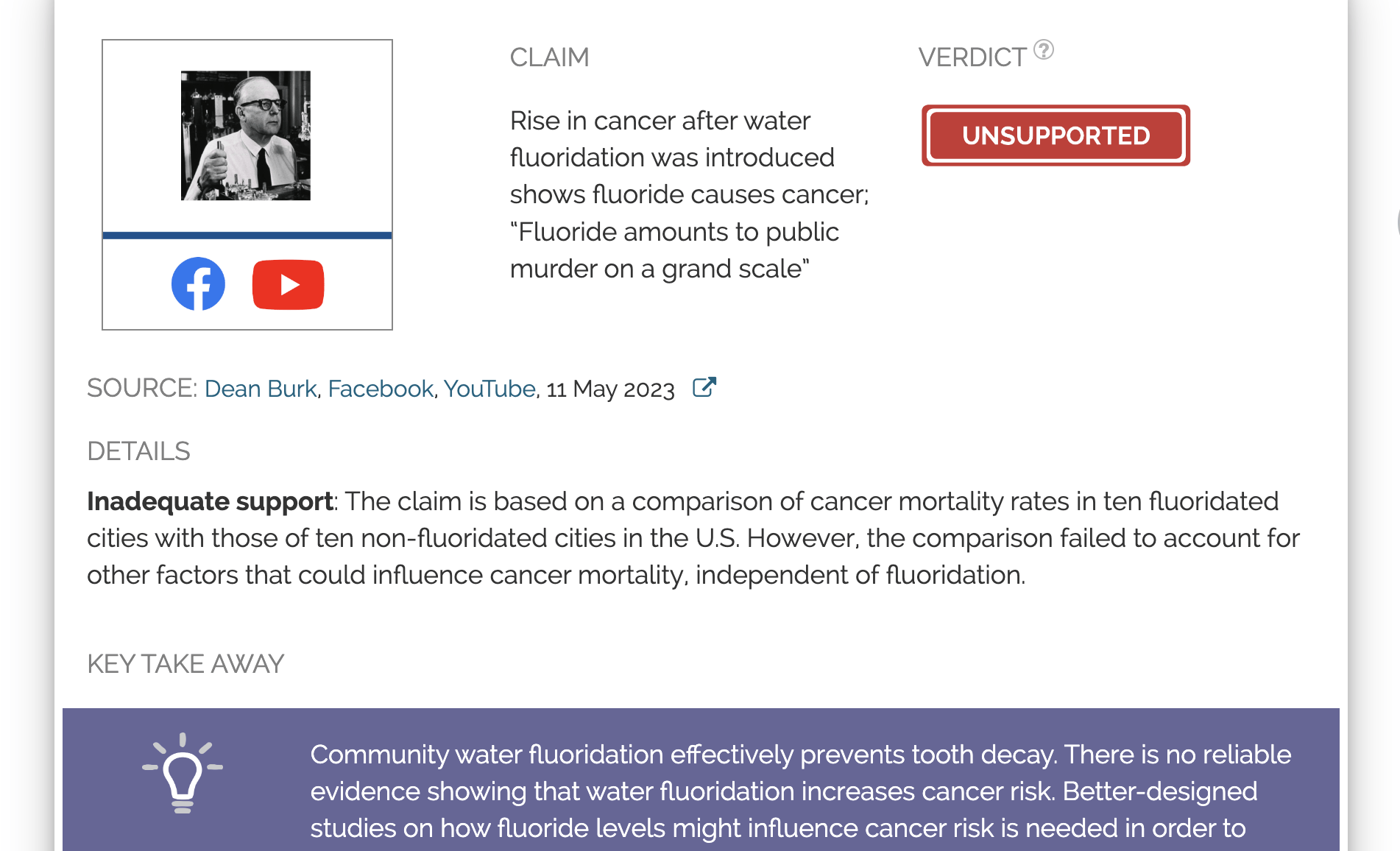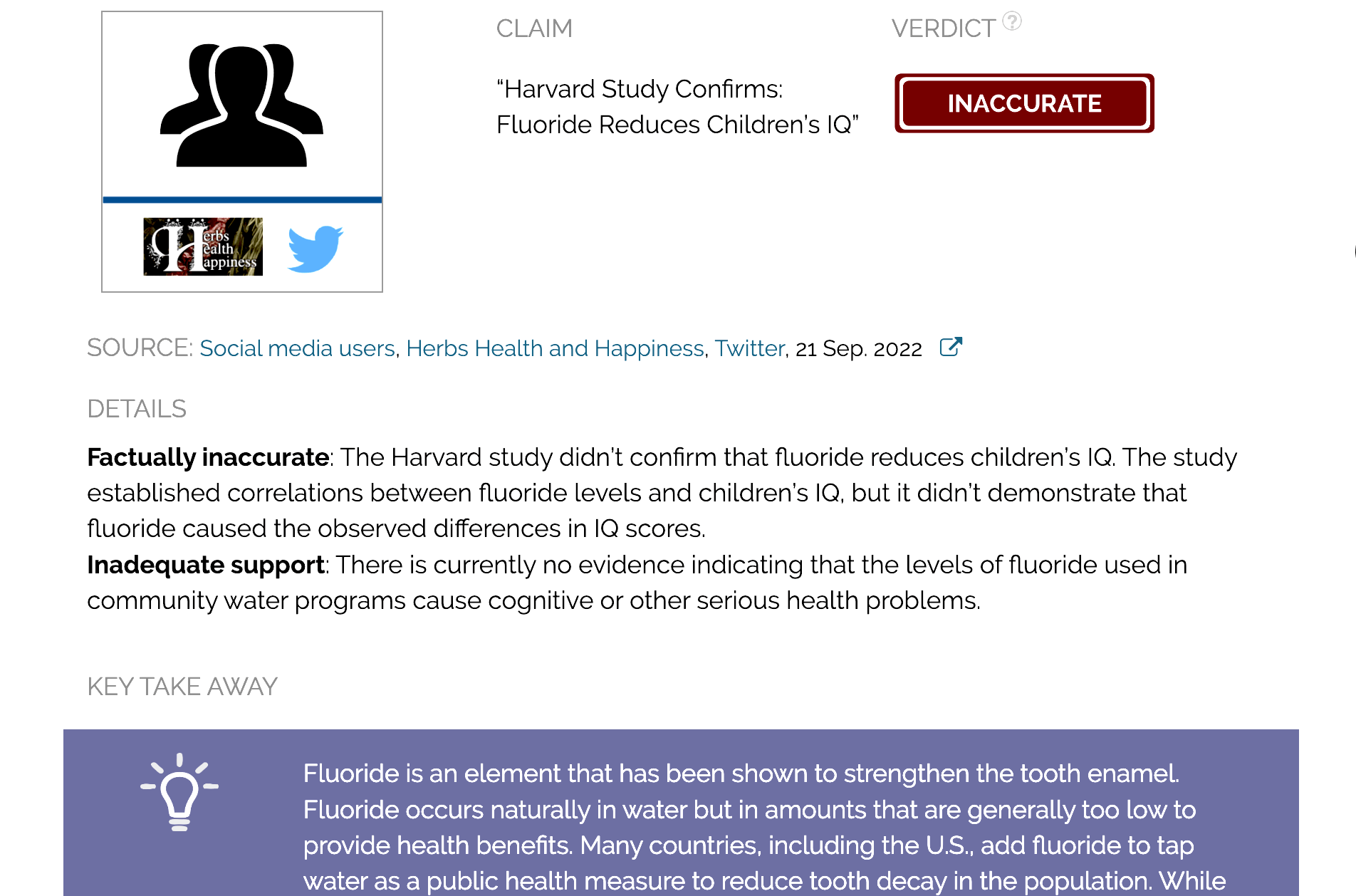- Health
Draft U.S. government report doesn’t conclude that fluoride is harmful at low levels
Key takeaway
Fluoride is added to community water across most of the U.S. and many other countries to reduce tooth decay. The levels used are considered to be safe by health authorities. Naturally high levels of fluoride in some parts of the world are associated with health problems and may be linked with lower IQ in children. A recently published draft report doesn’t provide evidence that the low levels used in the U.S. are harmful. An earlier draft under review by experts overstated the conclusions that could be drawn from the available data and was later rewritten following feedback.
Reviewed content

Verdict:
Claim:
“As fluoride goes up [...] IQ goes down in the developing brains of our kids”
Verdict detail
Lack of context: The Instagram post didn’t mention that the sentence quoted is from an earlier draft of the report and was removed following experts’ reviews. The conclusion of the recently released version of the report didn’t claim there is an inverse relationship between fluoride exposure and childhood IQ.
Full Claim
“Here's the conclusion I pulled right off page 467 of the report: ‘The consistency of the data supports an inverse association between fluoride exposure and children’s IQ.’”; “That means as fluoride goes up (from drinking water, toothpaste, dental cleanings, etc), IQ goes down in the developing brains of our kids.”
Review
In March 2023, a draft report by the U.S. National Toxicology Program (NTP) on the safety of fluoride was released following a court order. A widely-shared video on Instagram made misleading claims about fluoride safety by quoting from an earlier draft of the report, which was released at the same time and had already been edited following expert review.
Fluoride is an ion that is effective at preventing tooth cavities by strengthening enamel[1]. A 2018 report from the U.S. National Center for Health Statistics estimated that tooth decay affected 21.4% of the U.S. population aged two to five and 50.5% of those aged six to eleven.
To prevent tooth decay, fluoride is regularly added to toothpaste and mouthwash, and some countries add it to municipal drinking water. According to the U.S. Centers for Disease Control and Prevention, about 73% of the U.S. population receives fluoridated community water.
In some regions of the world, fluoride is naturally present in local water supplies at levels that are harmful to health[2]. This can cause skeletal fluorosis, where the bones and joints are damaged by accumulating excessive fluoride.
As has been covered by Health Feedback previously (here, here, here, and here), low fluoride levels to prevent tooth decay are considered to be safe, despite many misleading online claims to the contrary.
The Instagram video quoted from an old draft report that was altered after expert review
The NTP fluoride report had been planned for release in May 2022, but was delayed until the authors could address the concerns of expert reviewers. A lawsuit by opponents of water fluoridation forced the draft report to be published, together with an appendix containing the reviewers’ comments and an earlier draft version.
The Instagram video claimed that the report’s conclusion was “The consistency of the data supports an inverse association between fluoride exposure and children’s IQ.” An inverse association between fluoride exposure and children’s IQ would mean that in areas with high fluoride levels, we would observe lower IQs among children and vice versa.
However, the current version of the report didn’t contain this conclusion. The sentence quoted by the Instagram video came from an earlier version that was reviewed by experts, who did not consider that the conclusion was justified based on the existing evidence. The earlier version of the report was included in an appendix of the documents released in the lawsuit.
The reviewers commented that the studies analyzed in the report were based on fluoride exposure levels well above that found in fluoridated water in the U.S., typically 0.7 milligrams of fluoride per liter of drinking water. This is less than half the upper limit in the guidelines from the World Health Organization of 1.5 mg per liter.
None of the 19 high-quality studies relating to children’s IQ analyzed in the report was carried out in the U.S. These included areas with naturally occurring high fluoride levels of up to 9.4 mg per liter, well above safe levels[3].
In response to the comments from experts, the authors of the report edited their conclusion “to clarify that our moderate confidence conclusion is primarily based on studies with total fluoride exposure that approximates or exceeds what is generally associated with consumption of optimally fluoridated water in the United States.”
The latest version of the report, which is still in draft form, didn’t conclude there is an inverse relationship between fluoride and IQ. The authors now say:
“This review finds, with moderate confidence, that higher fluoride exposure (e.g., represented by populations whose total fluoride exposure approximates or exceeds the World Health Organization Guidelines for Drinking-water Quality of 1.5 mg/L of fluoride) is consistently associated with lower IQ in children. More studies are needed to fully understand the potential for lower fluoride exposure to affect children’s IQ.”
In short, the report’s conclusions don’t have any bearing on the current guideline for optimum fluoridation levels in the U.S. By claiming an inverse relationship between fluoride levels and children’s IQ, the Instagram video wrongly suggests that there is no safe level of fluoride. It also failed to explain that there was no evidence for harm at low levels.
The report doesn’t prove that fluoride leads to lower IQ
Fluoride was first added to local community water in the U.S. in 1945 and has since been used across most of the country. The American Academy of Pediatricians has concluded that there’s no reliable evidence for the claim that fluoride harms cognitive development.
Many other countries add fluoride to community water if levels are naturally low, including Australia and parts of the U.K. These countries have reviewed the available scientific evidence and established that the low levels added to water are safe and beneficial[3-6].
A previous report by the NTP in 2016 found a low-to-moderate level of evidence that non-human mammals exposed to fluoride had deficits in learning and memory at fluoride concentrations greater than 0.7 mg per liter. This latest report aimed to review the scientific literature to “evaluate the extent and quality of the evidence linking fluoride exposure to neurodevelopmental and cognitive effects in humans”.
The NTP report couldn’t establish whether fluoride could cause neurodevelopmental or cognitive effects. The report relied on observational studies that showed areas of high fluoride exposure had lower IQ in children, however these observations could be due to other indirect causes. There are several potential factors that would need to be accounted for, including exposure to lead or arsenic, iodine deficiency, socioeconomic status, parental education, or nutritional status. The NTP report’s authors acknowledged the difficulty of establishing if fluoride could be the direct cause of cognitive effects:
“Studies that evaluated fluoride exposure and mechanistic data in humans were too heterogenous and limited in number to make any determination on biological plausibility.”
The Instagram video didn’t explain this limitation and instead wrongly claimed that the report showed fluoride led to “neurological damage”.
In summary, the published draft of the NTP report doesn’t contain evidence suggesting that low-level exposure to fluoride is damaging. The Instagram video about the report quoted from an earlier version that was being reviewed by experts. The sentence quoted by the video was found to be unsupported by the evidence, and was replaced by the report’s authors.
REFERENCES
- 1 – Goodwin et al. (2022) Evaluation of water fluoridation scheme in Cumbria: the CATFISH prospective longitudinal cohort study. Public Health Research.
- 2 – Li et al. (2020) Spatial distribution of endemic fluorosis caused by drinking water in a high-fluorine area in Ningxia, China. Environmental Science and Pollution Research.
- 3 – U.S. Department of Health and Human Services Federal Panel on Community Water Fluoridation (2015) U.S. Public Health Service Recommendation for Fluoride Concentration in Drinking Water for the Prevention of Dental Caries. Public Health Reports.
- 4 – US Department of Health and Human Services. Public Health Service (1991) Review of fluoride: benefits and risks. Report of the Ad Hoc Subcommittee on Fluoride of the Committee to Coordinate Environmental Health and Related Programs. Morbidity and Mortality Weekly Report.
- 5 – McDonagh et al. (2000) Systematic review of water fluoridation. British Medical Journal.
- 6 -Spencer AJ. (2006) The use of fluorides in Australia: Guidelines. Australian Dental Journal.



